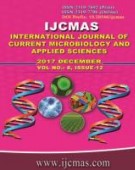


 National Academy of Agricultural Sciences (NAAS)
National Academy of Agricultural Sciences (NAAS)

|
PRINT ISSN : 2319-7692
Online ISSN : 2319-7706 Issues : 12 per year Publisher : Excellent Publishers Email : editorijcmas@gmail.com / submit@ijcmas.com Editor-in-chief: Dr.M.Prakash Index Copernicus ICV 2018: 95.39 NAAS RATING 2020: 5.38 |
Seed size is the important component for seed yield and an important trait for consumer preference. The seed size is governed by the genetic as well as environmental factors; however the enzymes responsible for the C and N compounds constitute the major seed biomass. To understand mechanisms governing seed size in lentil, the present investigation was carried out on carbon and nitrogen metabolism in nodules of two small (PL 4 and LL 699) and two bold (DPL 62 and IPL 406) seeded lentil cultivars during crop development. In spite of early flowering in bold seeded, they have sustained activities of carbon and nitrogen metabolising enzymes in them as compared to small seeded cultivars at later stages of development indicates that nodules in them remain active for a longer time. Nodules are site for metabolism of sucrose to provide the energy and carbon skeletons for biological nitrogen fixation. The activity of carbon metabolizing enzymes in nodules of bold seeded cultivars was found to be high. The activity of nitrogen metabolizing enzyme in nodules was found to be higher in all the cultivars during development. The main route for the assimilation of fixed nitrogen is GS/GOGAT pathway while GDH function at higher NH4+ concentration in young and senescing lentil nodules.
 |
 |
 |
 |
 |